Part 3 of the Nemegt Fauna Series. Review and photos by Bokisaurus, edited by Suspsy
Today’s review concludes the Nemegt Fauna review trilogy by looking at the Tarbosaurus figure by Favorite Co. Ltd. As I explained in my Saurolophus review, back in 2012, the Osaka Museum Of Natural History launched an impressive special exhibit that highlights the impressive diversity of dinosaur fossils found in Mongolia’s Gobi Desert. Along with the special exhibit were museum merchandise exclusives, of which two stood out. These are the Saurolophus and the Tarbosaurus, sculpted by the famous Hirokazu Tokugawa and released by Favorite.
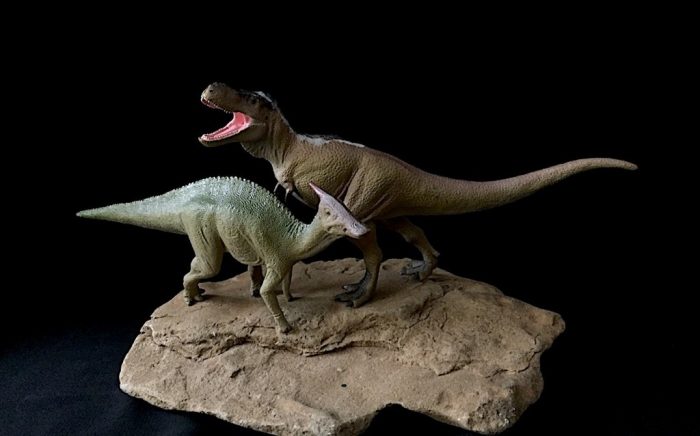
Tarbosaurus, meaning “alarming lizard,“ is a large Asian tyrannosaurid that was found in Late Cretaceous Mongolia. For a while, there were many species named, but officially, only one is currently accepted by scientists: Tarbosaurus bataar. Although part of the royal family that includes the most famous dinosaur of all, Tyrannosaurus rex, Tarbosaurus has not reached the same fame level despite sharing similar features and being only slightly smaller. While its cousin ruled North America, Tarbosaurus ruled over Asia. He was the undisputed king of the land, the apex predator. For a tyrannosaur, Tarbosaurus is well represented by dozens of near perfect fossil specimens, including the important skull. This bounty of fossil finds makes Tarbosaurus one of the most studied dinosaurs.

The Royal Family
Size-wise, Tarbosaurus was slightly smaller than T. rex, measuring between 10 and 12 metres long for the largest known individual. At 11 inches long and 5 inches tall, this figure is roughly around the 1:34 to 1:40 scale. The sculpt is beautiful and active with the head tilted to the side, and of course, like 99% of tyrannosaur figures, its mouth is wide open! Rich in details, the figure has some nice muscle definition that shows this one is in his prime. The head is nicely sculpted and easily identifiable as a tyrannosaur. My only criticism is that the teeth are small, blunt, and very uniform in size. This give it a rather funny look.
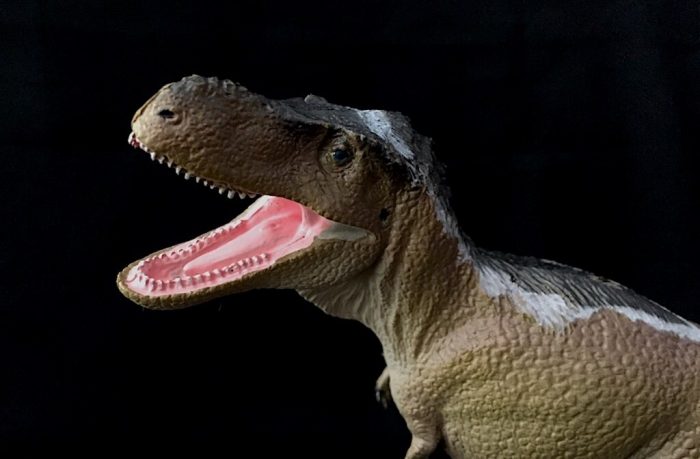
The figure is painted an overall olive brown with some lighter highlights. A darker brown band runs along the back starting at the hips and ending at the tip of the tail. It is not fully feathered. Instead, the feathers are concentrated at the head and nape area, giving this Tarbosaurus a shaggy look. These hair-like feathers are colored black with a thin outer ring colored white. These colours are perfect for the desert environment and the hunting style of this large predator. The browns would blend in perfectly with dried vegetation, concealing the animal as it waits for its prey.
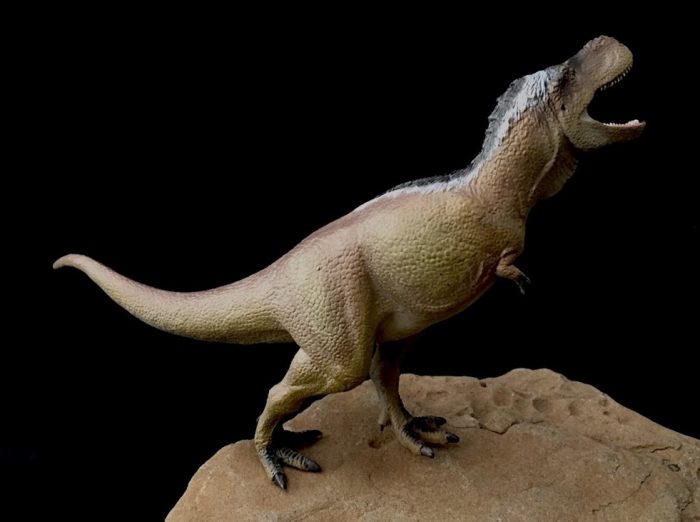
During the Late Cretaceous, what is now the Mongolian desert was then a lush environment with rivers, forests, savannas, and shallow lakes. This environment supported a vast and diverse range of large dinosaurs including Tarbosaurus. Imagine that the rainy season has just started and the surrounding land is starting to awaken. The rain not only rejuvenates the vegetation, but also signals the start of the migration season for some of the seasonal residents of this land. Patrolling his territory, a lone male Tarbosaurus surveys his domain for any signs of trespassing from neighboring rivals. His vast territory encompasses the lush forest edge and the dry plains below. At the center of his territory is a large, shallow lake that attracts many species of dinosaurs that are thirsty and hungry from their long journey. Only an animal at his prime can secure such rich hunting ground. At the edge of the forest where it meets the lake, a small corridor rich with vegetation is a perfect place to lay an ambush. The Tarbosaurus heads toward this corner of his territory. Along the way, he startles a small herd of Gallimimus and send them scurrying back out towards the open plain.
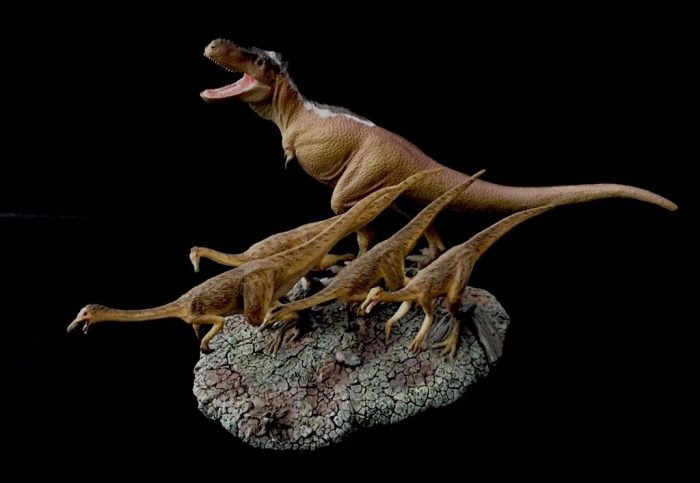
They are part of a vast herd numbering in the thousands on their migration journey. Our Tarbosaurus gives the herd a mock charge, but otherwise ignores the Gallimimus, as they are simply too fast for him to bother trying to take down. He is not built for fast running and agility. He is designed as an ambush predator, only bursting into speed only at the last second. He is after something much bigger and easier to catch than the fleet-footed Gallimimus. A scent suddenly captures his attention. It belongs to a predator, not another Tarbosaurus, but a close relative. It is Alioramus, a smaller tyrannosaur that also inhabits the region, although seasonally it spends its life wandering the plains and following the vast migrating herds like a shadow.
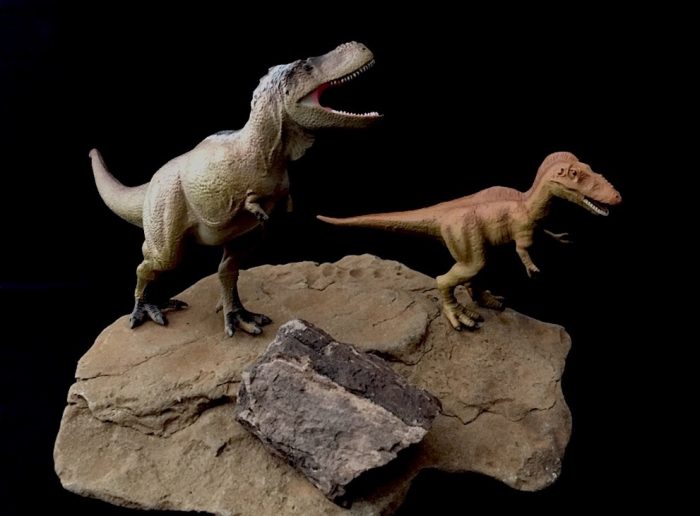
Although both animals are top predators, they avoid directly competing for the same food source by going after different prey animals. With its great size, Tarbosaurus goes after much larger prey, while Alioramus, being smaller but faster, tends to go after much smaller prey such as the Gallimimus and the various oviraptorids that inhabit the plains. To establish his dominance over this intruder, the Tarbosaurus charges toward the Alioramus, sending him running back towards the open plain. Satisfied that the intruder is no longer in his territory, the Tarbosaurus continues deeper into his favourite hunting ground.
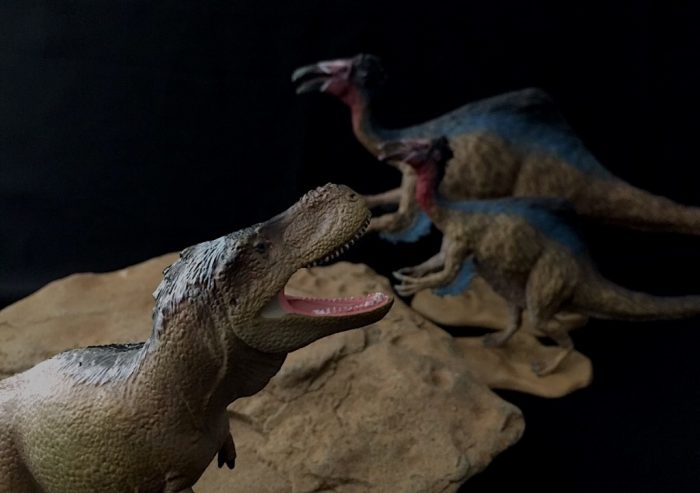
As he nears the forest edge, two pairs of eyes observe him from a distance. A pair of Deinocheirus nervously watches his every step. During the lean months, Deinocheirus is Tarbosaurus‘ main prey. Despite their size and their impressively large claws, Deinocheirus are not aggressive animals and would rather flee to the safety of the forest depths than stand and fight. Somehow, the familiar sounds echoing from the distant plains signals to the Deinocheirus pair that today, and for the next few months, they are not on Tarbosaurus‘ menu. Still, the pair disappears back to the safety of the forest. The Tarbosaurus has reached his destination and slowly enters a brush thicket. Here he squeezes himself between the dried vegetation and keeps perfectly still. Only the movement of his blue eyes betrays his presence. Soon, the reason for this inaction becomes clear as a small herd of Saurolophus comes into view. They are heading directly towards the corridor between the forest and the lake. The Tarbosaurus is on a hunt.
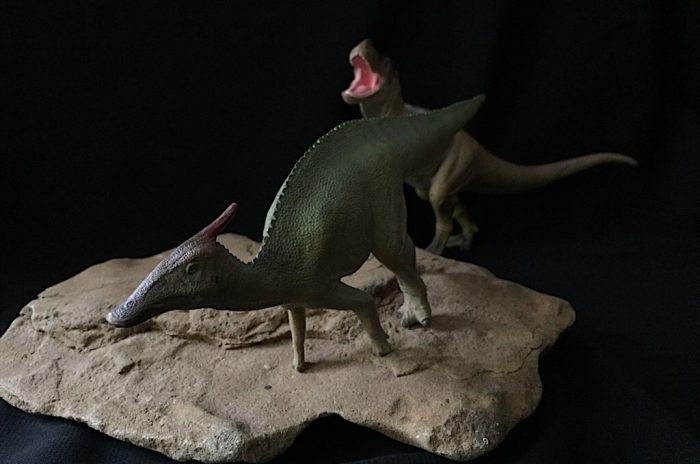
Unaware of his presence, the Saurolophus herd passes by him as they enter the corridor. The Tarbosaurus‘ blue eyes locked in on his target: a young female Saurolophus who has wandered away from the herd and is heading straight into his trap. Once he is certain that the youngster is close enough, the Tarbosaurus charges out of the thickets. His roar sends the Saurolophus herd running back towards the safety of the open plain . . . except for one. The young female.

Now separated from her herd, the Saurolophus runs toward the opposite direction, right into the forest and into the trap. With no way out, she is now trapped and cries desperately for her herd. This is the moment the Tarbosaurus has been waiting for. He runs straight towards the trapped youngster, blocking the only escape route. The desperate Saurolophus tries to enter the forest as the predator closes in. But before she can go any deeper, she was sent back running by another large animal emerging from the forest shadows.
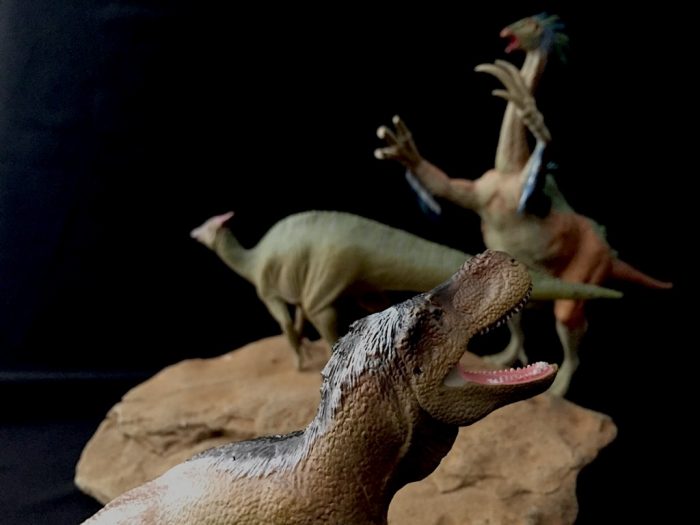
A large male Therizinosaurus emerges from the forest just as the Tarbosaurus is about to catch up with the Saurolophus. The predator’s unmistakable scent had caught the attention of the Therizinosaurus before he came predator within sight. Aggressive by nature and armed with deadly claws, the scent of the approaching Tarbosaurus has sent this Therizinosaurus into a blind rage. If there is anything that he hates the most, it is Tarbosaurus.
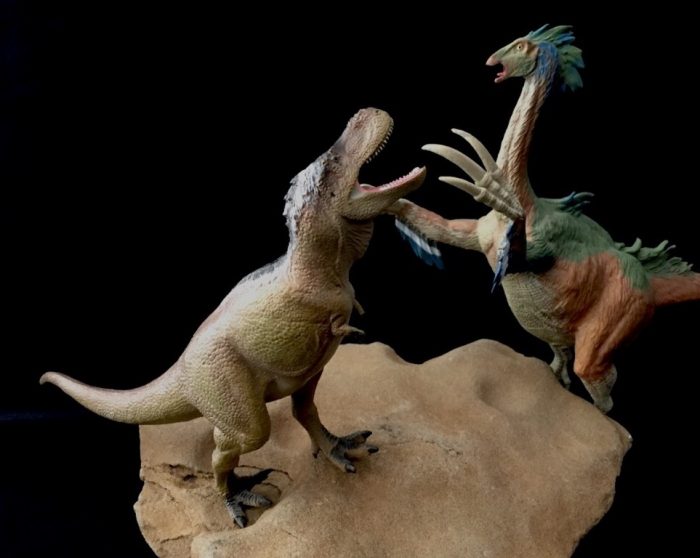
Although primarily a herbivore, Therizinosaurus is a formidable opponent for any predator. Its ill temper, large size, deadly claws, and habit of charging any danger instead of fleeing protects it from most attacks. Only a desperate predator would go after a healthy Therizinosaurus, and this Tarbosaurus generally avoids hunting them, although sick or injured animals have sometimes fallen prey. Now faced with this nemesis, Tarbosaurus narrowly misses a slashing claw aimed at his head. The unexpected encounter gives the young Saurolophus an escape route and she quickly bolts past the dueling titans and runs towards the open plain. The Therizinosaurus and Tarbosaurus circle each other, each one sizing up the other. With no sign of backing down, Therizinosaurus is gaining the upper hands as he pushes Tarbosaurus into a corner. Rather than risk injury, or worse, a fatal wound from those deadly claws, Tarbosaurus decides it’s best to retreat. He quickly turns and heads back towards the opposite side of the shallow lake, leaving the Therizinosaurus behind. With more and more migrating animals arriving each day, there are more opportunities for a successful hunt somewhere in his territory.
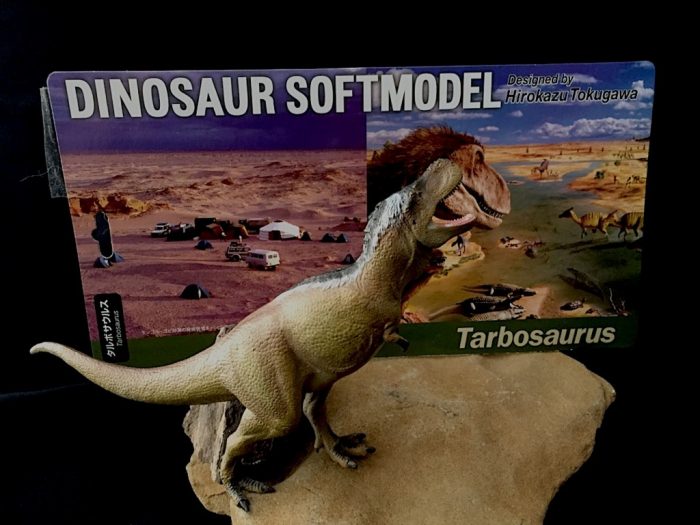
The story of life and death, predator and prey, and the complex relationships of the animals to one another and their environment has been playing out for millions of years. It will be millions of years before the curtain falls for these inhabitants of the vast Nemegt landscape. For now, the roars of Tarbosaurus and and all the other predators will continue to frighten prey animals. The cacophony of sounds that signals the arrival of the migrating herds will continue to echo throughout the vast plains and canyons as they once again fill the air with new life. Those strange and mysterious sounds from the forest dwellers will continue to enchant strangers, drawing them closer to its lush interior . . .
In closing, this Tarbosaurus figure is a welcome addition to any collection. It is well-crafted and jam-packed with details. It is also one of the few larger figures of the species currently available. Its size is perfect for those who likes their figures to be within the 1:40-ish range and displays nicely with other figures that are of the same scale. It may be a challenge and expensive to acquire this figure, but it is well worth the reward.

Well, we have now reached the end of my Nemegt Fauna Trilogy. We have met many fascinating inhabitants of this enchanting landscape along the way. I am glad that I was finally able to write reviews in this format, one that not only focuses on the subjects, but also includes other animals that lived alongside them. Thank you all for reading these reviews, and I hope that all of you enjoyed it as much as I had enjoyed writing them. Till the next review, cheers!
Disclaimer: links to Ebay and Amazon on the DinoToyBlog are affiliate links, so we make a small commission if you use them. Thanks for supporting us!




The most accurate theropod figure I have ever seen and more precisely a revolutionary Tyrannosaurs (Asian) figure, next to the PNSO Stan Wilson T.rex ( North American) in terms of scientific accuracy. Those who are blind JP fans, may not find quite excitement in this figure. Those who are willing to fascinate the actual lookings of these creatures, will find intense interest in this figure. It has all anatomical accuracies including the revolutionary addition of lips in a Tyrannosaurus figure which is praise worthy, having filled the accuracy gap in a Tyraannosaurus model. I have long been a the fan of Safari Ltd feathered T. rex of 2017 which have many inaccuracies in the skull region, but after viewing these two figures I have set my actual visionaries in a Tyrannosaurus figure.
I shall request Safari Ltd. to make another T.rex figure having only such dorsal protofeathers, rest smooth skinned body with fine addition of scales and with precisely accurate skulls having lips, the nasal-lachrymal and jugal osteoderms and osteoderm above the snout; which need a proper study of the skull of T.rex.
Very recently got a hold of this guy, he’s a lot shinier than I thought he’d be but it actually looks really nice in person. The short teeth annoyed me at first but now I don’t actually mind them at all.
Thank you for the excellent review!
A fine trio of reviews indeed!
With the exception of the teeth that as Laticauda has said are small or blunt (as if suffering from bursitis), it is still a great figure and a rare avis in the toy tyrannosauroids. What I like most about this figure is that it is perhaps the largest tyrannosauroids made excluding tyrannosaurus.
Unfortunately, except for the emblematic tyrannosaurus rex, the rest of the tyrannosauroids are poorly represented in terms of size and quality.
If we review the following companies in a quick way, Collecta (many of his figures are not bad, on the contrary they are excellent but in a rather small size), Safari (that is an exception yutyrannus its figure is good but the albertosaurus, gorgosaurus These last two need a reedición and in a bigger size) and guanlong (the latter worse than the prototype)) and on the other hand in Rebor (large size yutyrannus but not totally well done), as far as Favorite The one that is well represented from my point of view is the guanlong (model guanlong vs yinlong) comparable in genius to that of Kaiyodo) but the other tyrannosauroideos the bistahievesor and zhuchengtyrannus are only maintained on a basis and are not large models.
In short, except for exceptional cases, tyrannosauroids other than tyrannosaurus rex are not well represented in size and finish. We need companies like Favorite, Collecta, Papo, Rebor, PNSO, Schleich and Safari to make figures of those magnificent non-stop dinosaurs (regardless of whether they make standard figures). The world of toy needs well-represented tyrannosauriodeos, large size and better finished even if they are not scientists in some companies, is a recommendation that I make to dinosaur toy companies because it would generate very short term profits and purchases in so successful masses of both Children as collectors like those that causes the tyrannosaurus rex in its different versions and that would perpetuate in time.
We need tyrannosauroids other than T-Rex (although not to scale) larger and better represented in all senses
Very nice review and superb story telling. The only thing that bugs me with this toy is the teeth. They are small and uniform. I guess I am accustomed to bigger teeth. To many comic books as a kid I guess. If the model mouth is open, you might as well have some good chompers to go with it.
Thanks for that multifacetted review, I really like how you described the different animals and their (potential) behaviour.
And a very nice figure to choose for closing the series. Lovely theropod and finally one with lips (!!!). Can’t complain about the stubby” teeth, in the real animal you would only see the lesser part of the lenght of each tooth, but that they are all same size, yeah, that’s weird for an experienced sculptor as Tokugawa. Anyway a great figure.
Really enjoyable read. Thank you!
A delightful and intriguing review. Just the perfect companion for my early morning coffee. Thanks for the series!